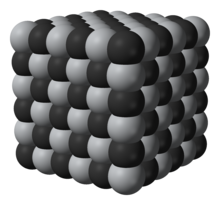You can help expand this article with text translated from the corresponding article in Ukrainian. (December 2024) Click for important translation instructions.
|

| |
| Names | |
|---|---|
| IUPAC name titanium carbide | |
| Other names titanium(IV) carbide | |
| Identifiers | |
| CAS Number | |
| 3D model (JSmol) | |
| ECHA InfoCard | 100.031.916 |
| PubChem CID | |
| UNII | |
| CompTox Dashboard (EPA) | |
InChI
| |
SMILES
| |
| Properties | |
| Chemical formula | TiC |
| Molar mass | 59.89 g/mol |
| Appearance | black powder |
| Density | 4.93 g/cm |
| Melting point | 3,160 °C (5,720 °F; 3,430 K) |
| Boiling point | 4,820 °C (8,710 °F; 5,090 K) |
| Solubility in water | insoluble in water |
| Magnetic susceptibility (χ) | +8.0·10 cm/mol |
| Structure | |
| Crystal structure | Cubic, cF8 |
| Space group | Fm3m, No. 225 |
| Coordination geometry | Octahedral |
| Except where otherwise noted, data are given for materials in their standard state (at 25 °C , 100 kPa).
| |
Titanium carbide, TiC, is an extremely hard (Mohs 9–9.5) refractory ceramic material, similar to tungsten carbide. It has the appearance of black powder with the sodium chloride (face-centered cubic) crystal structure.
It occurs in nature as a form of the very rare mineral khamrabaevite [uz] (Russian: Хамрабаевит) - (Ti,V,Fe)C. It was discovered in 1984 on Mount Arashan in the Chatkal District, USSR (modern Kyrgyzstan), near the Uzbek border. The mineral was named after Ibragim Khamrabaevich Khamrabaev, director of Geology and Geophysics of Tashkent, Uzbekistan. Its crystals as found in nature range in size from 0.1 to 0.3 mm.
Physical properties
Titanium carbide has an elastic modulus of approximately 400 GPa and a shear modulus of 188 GPa.
Titanium carbide is soluble in solid titanium oxide, with a range of compositions which are collectively named "titanium oxycarbide" and created by carbothermic reduction of the oxide.
Manufacturing and machining
Tool bits without tungsten content can be made of titanium carbide in nickel-cobalt matrix cermet, enhancing the cutting speed, precision, and smoothness of the workpiece.
The resistance to wear, corrosion, and oxidation of a tungsten carbide–cobalt material can be increased by adding 6–30% of titanium carbide to tungsten carbide. This forms a solid solution that is more brittle and susceptible to breakage.
Titanium carbide can be etched with reactive-ion etching.
Applications
Titanium carbide is used in preparation of cermets, which are frequently used to machine steel materials at high cutting speed. It is also used as an abrasion-resistant surface coating on metal parts, such as tool bits and watch mechanisms. Titanium carbide is also used as a heat shield coating for atmospheric reentry of spacecraft.
7075 aluminium alloy (AA7075) is almost as strong as steel, but weighs one third as much. Using thin AA7075 rods with TiC nanoparticles allows larger alloys pieces to be welded without phase-segregation induced cracks.
See also
- Metallocarbohedryne, a family of metal-carbon clusters including Ti8C12
References
- Dunn, Pete J (1985). "New mineral names". American Mineralogist. 70: 1329–1335.
- Chang, R; Graham, L (1966). "Low-Temperature Elastic Properties of ZrC and TiC". Journal of Applied Physics. 37 (10): 3778–3783. Bibcode:1966JAP....37.3778C. doi:10.1063/1.1707923.
- Fatollahi-Fard, Farzin (2017-05-01). Production of Titanium Metal by an Electrochemical Molten Salt Process (thesis thesis). Carnegie Mellon University.
- Gupta, P.; Fang, F.; Rubanov, S.; Loho, T.; Koo, A.; Swift, N.; Fiedler, H.; Leveneur, J.; Murmu, P.P.; Markwitz, A.; Kennedy, J. (2019). "Decorative black coatings on titanium surfaces based on hard bi-layered carbon coatings synthesized by carbon implantation". Surface and Coatings Technology. 358: 386–393. doi:10.1016/j.surfcoat.2018.11.060. hdl:2292/46133. S2CID 139179067.
- Sforza, Pasquale M. (13 November 2015). Manned Spacecraft Design Principles. Elsevier. p. 406. ISBN 9780124199767. Retrieved 4 January 2017.
- "New welding process opens up uses for formerly un-weldable lightweight alloy". newatlas.com. 13 February 2019. Retrieved 2019-02-18.
| Titanium compounds | |||||
|---|---|---|---|---|---|
| Titanium(II) |
| ||||
| Titanium(III) |
| ||||
| Titanium(IV) |
| ||||